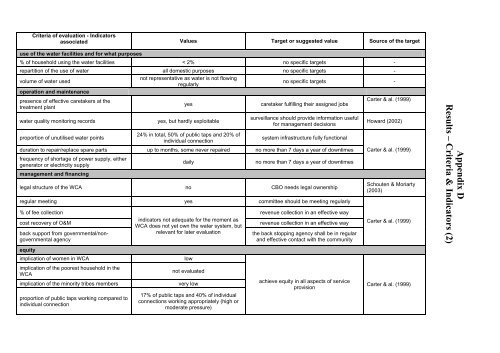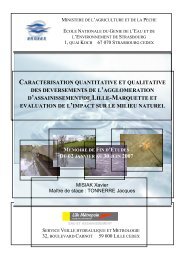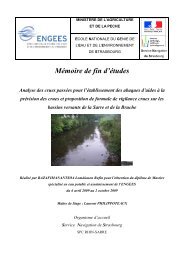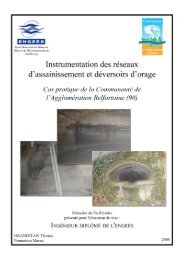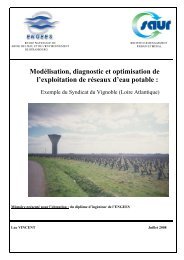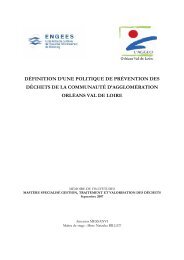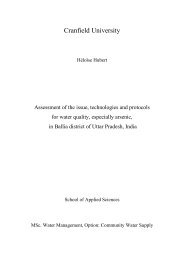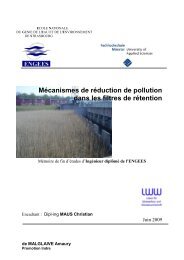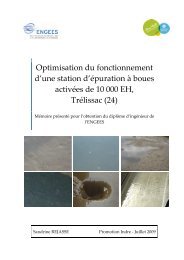Evaluation of water supply system Case study in Naka ... - ENGEES
Evaluation of water supply system Case study in Naka ... - ENGEES
Evaluation of water supply system Case study in Naka ... - ENGEES
- No tags were found...
You also want an ePaper? Increase the reach of your titles
YUMPU automatically turns print PDFs into web optimized ePapers that Google loves.
Criteria <strong>of</strong> evaluation - Indicatorsassociated Values Target or suggested value Source <strong>of</strong> the targetuse <strong>of</strong> the <strong>water</strong> facilities and for what purposes% <strong>of</strong> household us<strong>in</strong>g the <strong>water</strong> facilities < 2% no specific targets -repartition <strong>of</strong> the use <strong>of</strong> <strong>water</strong> all domestic purposes no specific targets -volume <strong>of</strong> <strong>water</strong> usednot representative as <strong>water</strong> is not flow<strong>in</strong>gregularlyno specific targets -operation and ma<strong>in</strong>tenancepresence <strong>of</strong> effective caretakers at theCarter & al. (1999)yescaretaker fulfill<strong>in</strong>g their assigned jobstreatment plant<strong>water</strong> quality monitor<strong>in</strong>g recordsproportion <strong>of</strong> unutilised <strong>water</strong> po<strong>in</strong>tsyes, but hardly exploitable24% <strong>in</strong> total, 50% <strong>of</strong> public taps and 20% <strong>of</strong><strong>in</strong>dividual connectionsurveillance should provide <strong>in</strong>formation usefulfor management decisions<strong>system</strong> <strong>in</strong>frastructure fully functionalduration to repair/replace spare parts up to months, some never repaired no more than 7 days a year <strong>of</strong> downtimesfrequency <strong>of</strong> shortage <strong>of</strong> power <strong>supply</strong>, eithergenerator or electricity <strong>supply</strong>management and f<strong>in</strong>anc<strong>in</strong>gdailyno more than 7 days a year <strong>of</strong> downtimeslegal structure <strong>of</strong> the WCA no CBO needs legal ownershipregular meet<strong>in</strong>g yes committee should be meet<strong>in</strong>g regularly% <strong>of</strong> fee collection revenue collection <strong>in</strong> an effective waycost recovery <strong>of</strong> O&M<strong>in</strong>dicators not adequate for the moment asWCA does not yet own the <strong>water</strong> <strong>system</strong>, butrevenue collection <strong>in</strong> an effective wayrelevant for later evaluationback support from governmental/nongovernmentalagencyequityimplication <strong>of</strong> women <strong>in</strong> WCAimplication <strong>of</strong> the poorest household <strong>in</strong> theWCAimplication <strong>of</strong> the m<strong>in</strong>ority tribes membersproportion <strong>of</strong> public taps work<strong>in</strong>g compared to<strong>in</strong>dividual connectionlownot evaluatedvery low17% <strong>of</strong> public taps and 40% <strong>of</strong> <strong>in</strong>dividualconnections work<strong>in</strong>g appropriately (high ormoderate pressure)the back stopp<strong>in</strong>g agency shall be <strong>in</strong> regularand effective contact with the communityachieve equity <strong>in</strong> all aspects <strong>of</strong> serviceprovisionHoward (2002)Carter & al. (1999)Schouten & Moriarty(2003)Carter & al. (1999)Carter & al. (1999)Appendix DResults – Criteria & Indicators (2)


